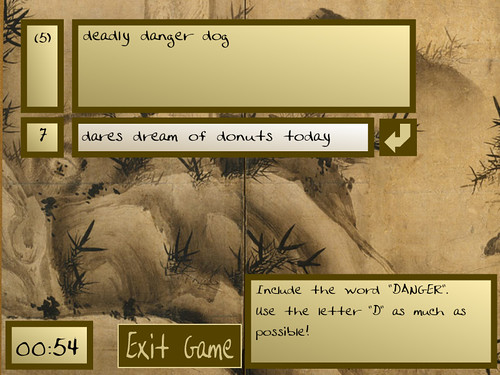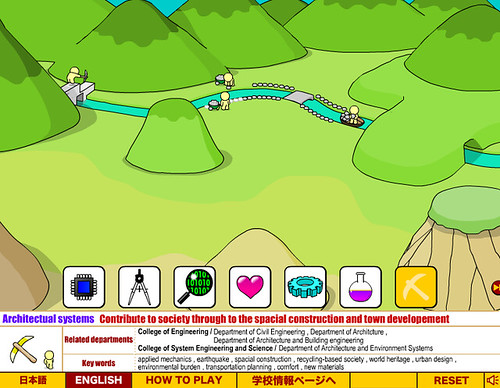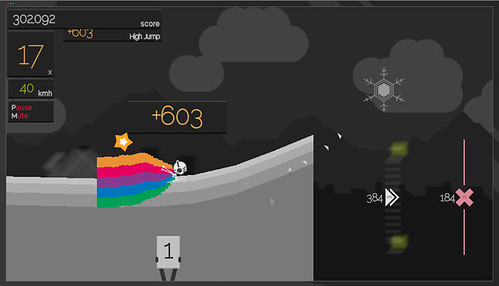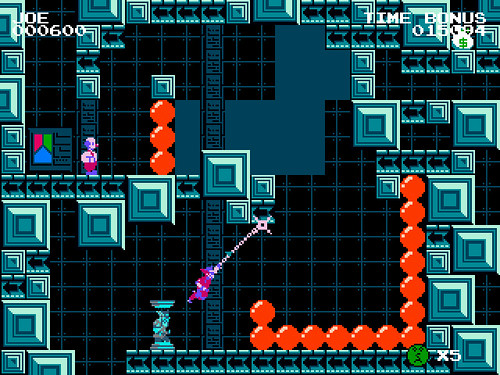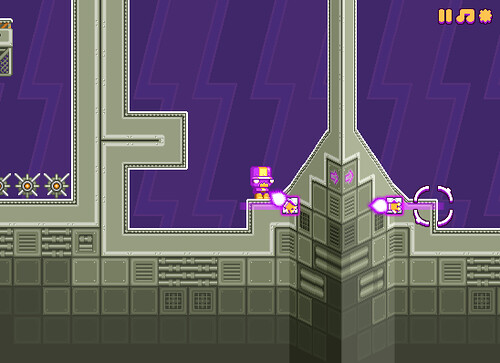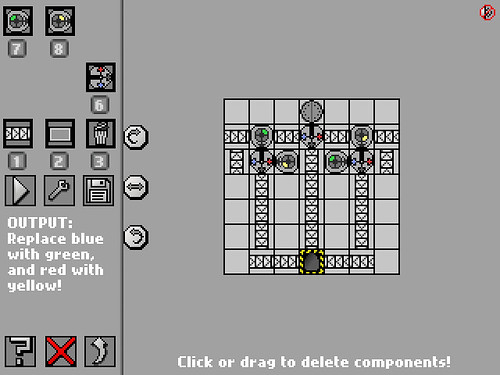Posts from ‘Browser Games’ Category
Minecraft Halloween Update Released
By: Derek Yu
On: October 31st, 2010
The almighty Notch has released a beefy update to Minecraft today that offers, among other things, an otherworldly new area with new block types and monsters. There are also “biomes”, which is a fancy word for different environment types (see the above video).
Notch also revealed that the “secret pixel artist” his company is hiring is none other than junkboy, the man responsible for this awesome series of demakes. Junkboy will be joining Oxeye Studios‘ Jeb and one other programmer on the talented new team that will be working on both Minecraft and an unannounced new game.
Haiku Hero
By: Derek Yu
On: October 4th, 2010
Haiku Hero is a game by Montoli/Paper Dino where you write haikus – three-line poems consisting of five, seven, and five syllables, respectively. There are three modes: a Deadline mode where you write as many haikus as you can in 5 minutes, a Survival mode where “good” haikus earn you more time, and a peaceful Endless mode where you can take your time and drink tea or rake sand gardens or whatever inspires you. The game determines whether your haiku is good based on whether you followed the 5-7-5 structure and whether you fulfilled the challenges that it set out for you based on one of three difficulty settings (e.g. “Use at least one word with 3 syllables.”).
It’s really quite fun, and I was surprised by how well the game was able to recognize fake, overused, or (for certain challenges) non-rhyming words. Ultimately, though, it’s up to you to decide whether you wrote a truly awesome poem, which is why a multiplayer version of Haiku Hero or an easy way to see other people’s haikus would be great. Also, for a game about such a delicate artform, I was pretty unimpressed with the presentation, which, while serviceable, is kind of ham-fisted.
TIGdb: Entry for Haiku Hero
Grow Valley
By: Derek Yu
On: August 30th, 2010
Eyezmaze has released another charming “Grow” game! Grow Valley is the sequel to Grow Island, which was created to introduce prospective students to the curriculum of Shibaura Institute of Technology. Valley introduces a fast-forward feature to the series, which is a welcome addition (as charming as the animations are, it can get a little tedious watching them over and over again).
For those new to the Grow series, they’re simple puzzle games that you solve by clicking panels in the right order. It sounds dull, but the games are actually quite creative and fun to play. By studying the interactions between the panels you can usually narrow down what the correct solution is.
TIGdb: Entry for Grow Valley
Solipskier
By: Derek Yu
On: August 12th, 2010
Mike Boxleiter and Greg Wohlwend (aka Mikengreg) have released a wonderful new game, called Solipskier. In Solipskier, you use your mouse to paint snow on the screen for a little guy to ski on. The skier will build up speed on downslopes and can perform jumps over gaps in the snow. The goal of the game is to obtain a highscore by skiing through gates and catching air to build up your multiplier.
It takes a while to learn how to build up speed effectively, but once you get going fast, it’s blissful (gotta love it when the heavy metal turns into wind as your headphones fly off). Solipskier is a very polished game, which is not surprising, considering that Mikengreg also worked on Fig. 8, Effing Hail, and Dinowaurs as part of the Intuition Games collective. But in my opinion, this is their most enjoyable release yet.
Solipskier is also available on the iPhone and iPad for $2.99.
TIGdb: Entry for Solipskier
Streemerz
By: Derek Yu
On: July 23rd, 2010
Glen “Radix” Forrester and Arthur “Mr. Podunkian” Lee have announced mak gam, their new game studio. This announcement coincides with their release of the FlashPunk version of Streemerz, a platformer based on the Action 52 game of the same name. Streemerz was created for Mr. Podunkian’s Action 52 project, where various developers sign up to create games based on the infamous Action 52 multi-game cart for the NES. As of writing, 20 of the 52 action-packed “gams” have been finished, and I believe there are still spots open if you want to participate (full list here).
In Streemerz you play as the lovable-but-misguided proletariat Superb Joe, who is out to topple the benevolent dictatorship of Master Y. Superb Joe is armed with a grappling hook (or “streemer”) which allows him to swing around and make his way through the flying fortress of Master Y. Like Bionic Commando, which the game parodies, the character is unable to jump and can only use his streemer to leave the ground.
Fault Line
By: Derek Yu
On: July 1st, 2010
[This is a guest review by Peevish. If you’d like to write a guest article for TIGSource, please go here.]
This month Fault Line was released.
I don’t know if you’ve been following Nitrome. I know I sure wasn’t. Their game Tiny Castle got a plug on the Indie Games Weblog as well as the AV Club’s Sawbuck Gamer column. And it was an interesting game, more for it’s idea that for how well it pulled it off.
But Fault Line has got me digging into their backlog.
In Fault Line, you play as a small and at least partially robotic hero working through a series of test chambers. Your primary ability: you can grab nodes on the walls and drag them together, compressing the Cartesian plane between:
Transformice
By: Derek Yu
On: June 20th, 2010
This is Transformice, and it is so much fun! There is an English version of the game available which now has quite a few people playing in it (the original game is in French). The video should explain the basics of how Transformice works, but there’s also a help menu available during the game.
Manufactoria
By: Derek Yu
On: May 31st, 2010
PleasingFungus’s Manufactoria is alternately stressing me out about old computer science courses as well as reminding me why I enjoy the challenge of programming. In the game you’re put in charge of accepting or rejecting robots based on their input, a sequence of red or blue dots. To beat each level you must devise a finite state machine that will read the input and send the robot to the “accepted” tile if the input passes the level’s requirements. For example, in the devious “Androids!” level, the requirement is “some number of blue, then the same number of red!”
To determine if your machine works, a test is run at the end of the level, sending down a number of robots, some with a fixed input and some with a randomized input. It is possible to design machines that work for the test but not for every possible input… but then you’d have to live in the horrifying shame of not finding a robust solution. (Although that’s probably not quite as shameful as having to look at someone else’s solution for Androids!, cough.)
Enough Plumbers
By: Paul Eres
On: May 17th, 2010
Enough Plumbers, by Radix and MrPodunkian is a well-crafted puzzle platformer with a cloning mechanic and character transformation power-ups. The action is secondary to the puzzle element, although there is some base level of dexterity required.
I thought the polish was very well done, particularly the music (although the Mario-like sounds every time you collect a coin do get a bit annoying after a while). The puzzles are also very clever; most of the puzzles later on require using several of the the different clones in different ways.
My only real complaint is that up is jump; I prefer some other keyboard button alternative, so that I can move with one hand and jump with the other. But because the game isn’t that action-based it wasn’t as big of a problem as it’d be otherwise.
The game is based on an earlier game of Radix’s called Enough Marios, which is simpler and less polished, and which I link to mainly because of its awesome cover art.
Where We Remain
By: Paul Eres
On: May 15th, 2010
Where We Remain was released back in January by TwoFoldSecret. From the image, older readers such as myself will first spot Zelda 1 references — the trees (their shape and color) and the statues, which look like Armos statue edits; even the caves are just black squares. The game is also about non-linear exploration, with saving a girl as the goal given to the player. Some of the items are similar too: a map, a compass, a raft, and so on. Also similar is the idea of lots of abilities for which you have to discover the use for through experimentation.
But the game itself is otherwise distinct; there are multiple endings, and the map is procedurally generated. Instead of enemies that kill you and a life bar of hearts, there is a flower and whirlwind-like monster system, with many of the abilities revolving around avoiding those monsters. There are also notes scattered around, especially in expert mode, which tell the background story of the game in a way that you can take or leave. Read the rest of this entry »
